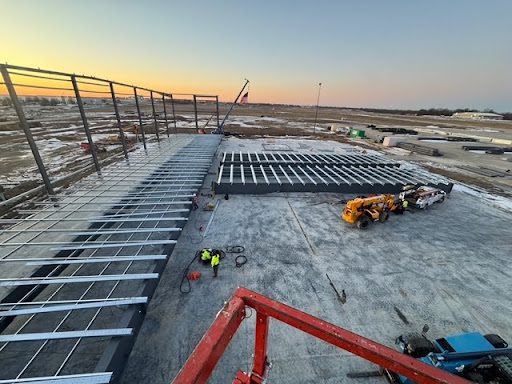A metal building is only as strong as its foundation. Whether you’re constructing a warehouse, manufacturing facility, or storage unit, a well-built foundation is critical for structural integrity, longevity, and avoiding costly repairs. Yet, many builders make preventable mistakes that lead to shifting, cracking, and water damage. To help you avoid these pitfalls, we’re listing the five most common foundation mistakes and how to prevent them. Let’s get started!
1. Poor Site Preparation
Before a single ounce of concrete is poured, the building site needs proper preparation. Rushing this step can lead to foundation shifting, settling, or even complete failure.
Why It’s a Problem:
- Uneven ground causes structural instability over time.
- Poor drainage leads to water pooling and soil erosion beneath the foundation.
- Loose soil creates weak points that can crack under the building’s weight.
How to Avoid It:
✅ Conduct soil testing to determine load-bearing capacity.
✅ Level and compact the ground before laying the foundation.
✅ Install a proper drainage system to divert water away from the slab.
✅ Consider using geo-fabric and crushed stone as a base layer for extra stability.
💡 Pro Tip: If your site has clay-heavy soil, add a layer of sand or gravel to improve drainage and prevent excessive expansion/contraction.
2. Choosing the Wrong Foundation Type
Not all metal buildings require the same type of foundation. Using the wrong one can lead to unnecessary stress on your structure.
Common Foundation Types:
- Slab-on-Grade – Best for warehouses and workshops in areas with firm, stable soil.
- Pier & Beam – Ideal for unstable or shifting soils, allowing for adjustments over time.
- Perimeter Wall with Footings – Used for large commercial buildings requiring extra load support.
How to Avoid Mistakes:
✅ Consult an engineer to determine the right foundation for your soil type.
✅ Use the correct thickness (minimum 4 inches for most slabs; 6 inches for heavy loads).
✅ Reinforce with rebar or mesh to prevent cracking and shifting.
💡 Pro Tip: Don’t forget to check local building codes—they often dictate minimum foundation depth and reinforcement requirements.
3. Incorrect Anchor Bolt Placement
Anchor bolts secure the metal frame to the foundation. If they are misplaced, it can lead to expensive rework—or worse, a structurally weak building.
Why It’s a Problem:
- Misaligned bolts make it impossible to properly attach the frame.
- Bolts set too shallow can loosen over time due to vibration.
- Over-tightening can crack the concrete around the bolt, reducing strength.
How to Avoid It:
✅ Use pre-engineered bolt templates for accurate placement.
✅ Follow manufacturer-recommended spacing (typically every 4-6 feet).
✅ Ensure bolts are at least 12 inches deep into the concrete for proper anchoring.
💡 Pro Tip: In high-wind or seismic-prone areas, consider using high-strength epoxy anchor bolts for added durability.
4. Ignoring Moisture & Drainage Issues
Water is one of the biggest threats to metal building foundations. If moisture isn’t properly managed, it can weaken the concrete and cause rust on the structure’s frame.
Common Causes of Moisture Problems:
- No vapor barrier installed under the slab.
- Poor drainage planning, allowing water to seep under the foundation.
- Incorrect slab slope, which should be at least 1/8 inch per foot for drainage.
How to Prevent It:
✅ Install polyethylene vapor barriers before pouring concrete.
✅ Ensure the foundation is at least 6 inches above grade to prevent flooding.
✅ Use sealants and expansion joints to protect against water intrusion.
✅ Consider French drains or a gravel perimeter if the site has poor natural drainage.
💡 Pro Tip: For buildings in humid or flood-prone areas, investing in waterproof concrete mix can significantly reduce long-term moisture damage.
5. Not Accounting for Expansion & Contraction
Metal expands and contracts with temperature changes. If the foundation doesn’t allow for movement, stress cracks and structural damage can occur.
Why It’s a Problem:
- No expansion joints → leads to foundation cracking over time.
- Rigid structure-to-foundation attachment → prevents the natural movement of the building.
How to Prevent It:
✅ Install expansion joints every 20 feet in large foundations to allow for movement.
✅ Use a floating slab design for greater flexibility.
✅ Ensure there’s proper spacing between the metal frame and foundation to accommodate shifts.
💡 Pro Tip: If using Butler MR-24 roofing systems, the built-in floating clip system can help reduce stress on the foundation by allowing for natural expansion and contraction.
Wrapping Up
Your metal building is a long-term investment, and avoiding these five common foundation mistakes can save you from expensive repairs and structural failures.
✅ Prepare your site properly to prevent shifting and settling.
✅ Choose the right foundation type based on soil conditions and building needs.
✅ Ensure accurate anchor bolt placement to avoid costly fixes.
✅ Plan for moisture control to extend the life of your foundation.
✅ Allow for expansion and contraction to prevent cracking and movement issues.
By following these guidelines, you’ll set your metal building up for success, longevity, and durability. For expert assistance with your next metal building project, reach out to MAR Building Solutions – Kansas City’s go-to metal building contractor.


